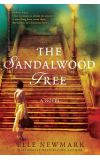
02 May 2011 23:25:33
The narrative switches between India in two generations, the mid-19th century and post-World War II. The 1947 narrator is Evie, an American whose marriage is on the rocks after her husband returned a changed man from the war. When he wins a Fulbright scholarship to document the end of British colonial rule in India, the family (they have a 5-year-old son, Billy) joins him for an exotic adventure that Evie hopes will be a new beginning for them all.
Newmark's first sentence drops the reader into a colorful, noisy and fragrant place: "Our train hurtled past a gold-spangled woman in a mango sari, regal even as she sat in the dirt, patting cow dung into disks for cooking fuel." She has a knack for description that makes it easy to close your eyes and see, hear and smell the story in your mind.
It's not long after they move into their bungalow that Evie discovers a stash of letters behind a kitchen wall. In epistolary style, we're then introduced to Felicity Chadwick and Adela Winfield, young British women who fail to find husbands in England and are shipped off to India by their families in the hope they'll have better luck there. They make their home from 1856 to 1858 in the bungalow Evie inhabits nine decades later, and their story sparks a curiosity in Evie.
As she pieces it together and India moves closer to civil war, the search takes on a frantic tone, as if solving the mystery of what happened to Felicity and Adela will somehow help Evie find her own peace. It's a compelling tale. You want to turn the page and find out what happens.
Newmark deftly blends history and fiction to create a novel that transports the reader and by the end reveals "the unexpected ways people are connected and how we touch each other through space and time. It could almost make a person believe in ... something."

